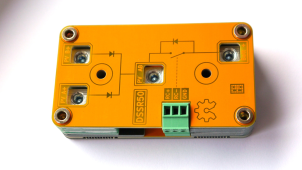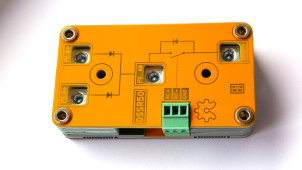Electrodacus DSSR50
it stands for "digital solid state relay 50
and the 50 number designation is for the 50 amp capable design....
(((= solar PV charge controller when used with the Electrodacus SBMS0)))
The PV A+ input terminal can do 25amps and PV B+ input terminal can do 25 amps.
The DSSR50 input terminals are more robust.... a definite plus for the new DSSR50 !!!!
Each input is rated for 25 amps, so with two inputs each Electrodacus DSSR50 can deliver up to 50 amps of charging power to your energy storage battery... the Batt + terminal is then connected to the battery on the positive side or to your positive battery busbar...
I use a copper busbar for multiple positive connections.... and a negative busbar for the negative connections.... [[[color coded red or black for ready identification... red insulators or black insulators]]].
I bought 4 of the Electrodacus DSSR50 components so I could charge 200 amps into my LiFePO4 energy storage battery from 16 solar PV panels and
can continue expanding as time and resources permit.
The Electrodacus SBMS0 can control up to 18,000 watts of solar PV panels....
When controlled by the Electrodacus SBMS0 via small control wires 23 gauge or so (standard ethernet cables) the solid state relay is closed and allows the maximum charge from the solar PV panels to charge the battery. (((I preferred the solid-strand copper ethernet cables with 4 twisted pairs...)))
The internet website Electrodacus.com has a downloadable pdf user manual for the Electrodacus DSSR50 and the Electrodacus SBMS0 etc.
The Electrodacus SBMS0 is the solar battery management system to protect and properly/safely charge and equally important control the discharge of your
expensive LiFePo4 energy storage battery. (((this is my battery of choice presently.))) do not want to overcharge or over-discharge the expensive LiFePO4 battery.... I use 272AH cells or 280AH cells in 24-volt configurations.... so a 4P8S battery (32 cells) is rather expensive and a 2P8S battery (16 cells)is also quite expensive... I think this is definitely the most expensive part of the off-grid solar PV system ( the battery (aka energy storage system)).... ??
You will find that the energy storage battery is the most expensive part of the off-grid solar PV system.... and the BMS (battery management system) is also a critical part to keep the battery charged and discharged correctly for a long life span (hopefully) ?
The Electrodacus components are
designed for up to 24-volt nominal systems.... not designed for higher voltage....
the designer chose to keep them low voltage for a safe end-user experience.... you still need to utilize good safety practices when working with 24-volt equipment.... it will work with 12-volt setups also but I am only working with the 24-volt for the Electrodacus components at my off-grid farm...
It rained hard yesterday and the sun is predicted to be mostly hidden by the clouds today so good for some outside time....
have a great relaxing Sunday ?









